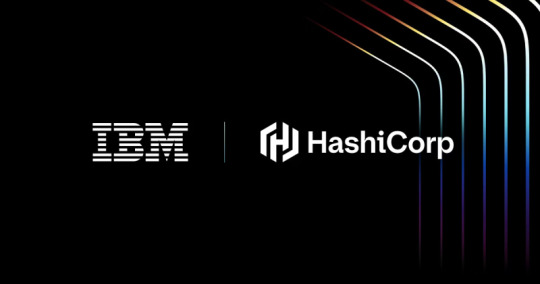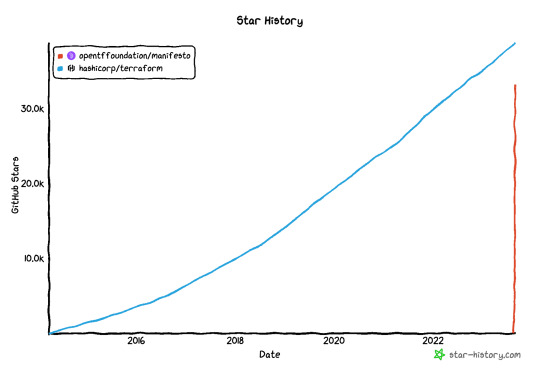#Hashicorp
Explore tagged Tumblr posts
Text
Terraform: Clone Linux VM From Template
In this article, I will go through the deployment details of an Ubuntu Linux virtual machine. Just one file, with user/password information, and only hardcoded values. This is a bit unflexible and maybe not the best way to work with Terraform files, but for the use case of my customer it was absolutely fine. For now, we just need to see if / how it works. Ubuntu Linux I installed a template VM…

View On WordPress
#API#Automation#Go#HashiCorp#iac#SDDC#Terraform#vCenter#vCenter 7#vCenter 8#VMware#vsphere#vSphere 7.0#vSphere 8.0
0 notes
Text
How to Enable MFA Using TOTP in HashiCorp Vault
1 note
·
View note
Text
IBM, bulut hizmetlerini genişletmek için HashiCorp'u 6,4 milyar dolara satın alacak

IBM Corporation, beklendiği gibi, bulut altyapısını yönetmek için bir dizi açık araç geliştiren HashiCorp'u satın almak için bir anlaşma yaptığını duyurdu . Şirket 6,4 milyar dolara satılıyor. Anlaşmanın koşulları uyarınca IBM, HashiCorp'u menkul kıymet başına 35 ABD doları karşılığında satın alıyor. HashiCorp ürünlerinin, müşterilerin BT altyapısının yaşam döngüsünü yönetmek için otomasyon araçlarını kullanmalarına olanak tanıdığı, ayrıca hibrit ve çoklu bulut ortamlarının oluşumuna da yardımcı olduğu belirtiliyor. Aynı zamanda şirketler ve kuruluşlar, çeşitli sağlayıcıların bulut kaynaklarını kullanarak iş ihtiyaçlarına en uygun platformu oluşturabilirler. IBM için bu anlaşma, hibrit bulut konseptini geliştirmeyi ve iddia ettiği iki "dönüştürücü teknoloji" olan yapay zeka araçlarının yaygın biçimde benimsenmesini amaçlayan daha büyük bir girişimin parçası. HashiCorp'un çözümleri, IBM ve Red Hat ürünleriyle bir araya gelerek müşterilere, şirket içi ortamların yanı sıra hiper ölçekli ve özel bulutlar da dahil olmak üzere çeşitli altyapılarda iş yüklerinin devreye alınmasını ve koordinasyonunu otomatikleştirecek bir platform sağlayacak. Her iki tarafın yönetim kurulları da bu işlem üzerinde anlaşmaya vardı. Artık HashiCorp hissedarlarından ve düzenleyicilerinden onay alması gerekiyor. İşlemin 2024 yılı sonuna kadar tamamlanması bekleniyor. Read the full article
0 notes
Video
Oh man, probably looked better before Unity shat themselves
♬ Just announced: Tue Oct 10, 5:30pm: SF GAME DEVELOPMENT MEETUP https://www.dnalounge.com/calendar/2023/10-10a.html #dnalounge #sfgamedevelopmentmeetup #sanfrancisco
SF Game Development Meetup: SF Game Development is excited to partner with HashiCorp and Unity. HashiConf is happening this week, and this is one of the exclusive after hours events that you’ll get to attend for FREE. Food is sponsored by HashiCorp and drinks are available for purchase at the DNA Lounge bar. Speakers will go on stage at 7:00pm. This event is open to the public and is a professional networking event for game developers, artists, students, indies, or really anyone interested in game development.
#Unity#unity engine#game dev#DNA Lounge#HashiCorp#what does HashiCorp even do#that would related to game dev?#I mean yeah#you might run HashiCorp stuff for your infrastructure#but that's like...#IDK#'game development with Pacific Power'#because you use electricity from them to run the office#San Francisco#I wonder if JWZ will be there#and be his grumpy ex-dev self about it#that would be great#he wouldn't grump too much about something bringing money in though
2 notes
·
View notes
Text
Learn HashiCorp Vault in Kubernetes Using KubeVault

In today's cloud-native world, securing secrets, credentials, and sensitive configurations is more important than ever. That’s where Vault in Kubernetes becomes a game-changer — especially when combined with KubeVault, a powerful operator for managing HashiCorp Vault within Kubernetes clusters.
🔐 What is Vault in Kubernetes?
Vault in Kubernetes refers to the integration of HashiCorp Vault with Kubernetes to manage secrets dynamically, securely, and at scale. Vault provides features like secrets storage, access control, dynamic secrets, and secrets rotation — essential tools for modern DevOps and cloud security.
🚀 Why Use KubeVault?
KubeVault is an open-source Kubernetes operator developed to simplify Vault deployment and management inside Kubernetes environments. Whether you’re new to Vault or running production workloads, KubeVault automates:
Deployment and lifecycle management of Vault
Auto-unsealing using cloud KMS providers
Seamless integration with Kubernetes RBAC and CRDs
Secure injection of secrets into workloads
🛠️ Getting Started with KubeVault
Here's a high-level guide on how to deploy Vault in Kubernetes using KubeVault:
Install the KubeVault Operator Use Helm or YAML manifests to install the operator in your cluster. helm repo add appscode https://charts.appscode.com/stable/
helm install kubevault-operator appscode/kubevault --namespace kubevault --create-namespace
Deploy a Vault Server Define a custom resource (VaultServer) to spin up a Vault instance.
Configure Storage and Unsealer Use backends like GCS, S3, or Azure Blob for Vault storage and unseal via cloud KMS.
Inject Secrets into Workloads Automatically mount secrets into pods using Kubernetes-native integrations.
💡 Benefits of Using Vault in Kubernetes with KubeVault
✅ Automated Vault lifecycle management
✅ Native Kubernetes authentication
✅ Secret rotation without downtime
✅ Easy policy management via CRDs
✅ Enterprise-level security with minimal overhead
🔄 Real Use Case: Dynamic Secrets for Databases
Imagine your app requires database credentials. Instead of hardcoding secrets or storing them in plain YAML files, you can use KubeVault to dynamically generate and inject secrets directly into pods — with rotation and revocation handled automatically.
🌐 Final Thoughts
If you're deploying applications in Kubernetes, integrating Vault in Kubernetes using KubeVault isn't just a best practice — it's a security necessity. KubeVault makes it easy to run Vault at scale, without the hassle of manual configuration and operations.
Want to learn more? Check out KubeVault.com — the ultimate toolkit for managing secrets in Kubernetes using HashiCorp Vault.
1 note
·
View note
Text
7 Hashicorp Vault Alternatives in 2024
7 Hashicorp Vault Alternatives in 2024 #devops #hashicorpvault #secretsmanagement #security #cybersecurity #plaintextpasswords #cicdpipelines #cloudsecrets #azurekeyvault #awssecretsmanager #akeyless #cyberarkconjur #mozillasops #doppler #kubernetes
Hashicorp Vault is a popular solution for ones looking at secrets management with DevOps and other workflows. However, there are alternatives out there that have similar features and may offer a better solution for your use case. We will consider 7 Hashicorp Vault alternatives in 2024 to see which one might suit your needs best. Table of contentsBrief overview of Hashicorp VaultWhy choose a…
0 notes
Text
Can HashiCorp Consul be used to monitor messages and fine-grained control over network traffic management in message brokers' producer-consumer-based process in a microservice architecture?
Yes, Consul can be used to monitor message failures or non-deliveries in message broker producer-consumer processes within microservices architectures, but with some limitations and considerations. Consul primarily functions as a service discovery and configuration management tool, providing features such as service registration, health checks, and key-value store. While Consul itself doesn’t…
View On WordPress
#Best Practices#Consul#Hashicorp Consul#interview questions#Interview Tips#message broker#Microservices#network traffic management#Senior Developer#Software Architects
0 notes
Text
throwback to that time Terraform changed its pricing plan and I asked my colleague to help estimate our new costs and instead of, oh I don't know, looking up the new pricing plan on the hashicorp website, he asked the AI chatbot on MS Bing. Still haven't recovered from it.
3 notes
·
View notes
Text
Terraform: Automated Deployment Experience
During my project work for a global player in the last years and as a member of a big professional services team, I learned new things regarding infrastructure deployments. One of our architects introduced me to Terraform and how to deploy virtual machines in just minutes. Terraform Associate Certification I recently decided to go for the certification provided by HashiCorp. It is not easy to…

View On WordPress
#API#Automation#Go#HashiCorp#photon#SDDC#Terraform#vCenter 7#vCenter 8#VMware#vSphere 7.0#vSphere 8.0
0 notes
Text
Running Docker Containers in HashiCorp Nomad: A Beginner’s Guide
http://securitytc.com/TGhNz9
2 notes
·
View notes
Text
Complete Terraform IAC Development: Your Essential Guide to Infrastructure as Code
If you're ready to take control of your cloud infrastructure, it's time to dive into Complete Terraform IAC Development. With Terraform, you can simplify, automate, and scale infrastructure setups like never before. Whether you’re new to Infrastructure as Code (IAC) or looking to deepen your skills, mastering Terraform will open up a world of opportunities in cloud computing and DevOps.
Why Terraform for Infrastructure as Code?
Before we get into Complete Terraform IAC Development, let’s explore why Terraform is the go-to choice. HashiCorp’s Terraform has quickly become a top tool for managing cloud infrastructure because it’s open-source, supports multiple cloud providers (AWS, Google Cloud, Azure, and more), and uses a declarative language (HCL) that’s easy to learn.
Key Benefits of Learning Terraform
In today's fast-paced tech landscape, there’s a high demand for professionals who understand IAC and can deploy efficient, scalable cloud environments. Here’s how Terraform can benefit you and why the Complete Terraform IAC Development approach is invaluable:
Cross-Platform Compatibility: Terraform supports multiple cloud providers, which means you can use the same configuration files across different clouds.
Scalability and Efficiency: By using IAC, you automate infrastructure, reducing errors, saving time, and allowing for scalability.
Modular and Reusable Code: With Terraform, you can build modular templates, reusing code blocks for various projects or environments.
These features make Terraform an attractive skill for anyone working in DevOps, cloud engineering, or software development.
Getting Started with Complete Terraform IAC Development
The beauty of Complete Terraform IAC Development is that it caters to both beginners and intermediate users. Here’s a roadmap to kickstart your learning:
Set Up the Environment: Install Terraform and configure it for your cloud provider. This step is simple and provides a solid foundation.
Understand HCL (HashiCorp Configuration Language): Terraform’s configuration language is straightforward but powerful. Knowing the syntax is essential for writing effective scripts.
Define Infrastructure as Code: Begin by defining your infrastructure in simple blocks. You’ll learn to declare resources, manage providers, and understand how to structure your files.
Use Modules: Modules are pre-written configurations you can use to create reusable code blocks, making it easier to manage and scale complex infrastructures.
Apply Best Practices: Understanding how to structure your code for readability, reliability, and reusability will save you headaches as projects grow.
Core Components in Complete Terraform IAC Development
When working with Terraform, you’ll interact with several core components. Here’s a breakdown:
Providers: These are plugins that allow Terraform to manage infrastructure on your chosen cloud platform (AWS, Azure, etc.).
Resources: The building blocks of your infrastructure, resources represent things like instances, databases, and storage.
Variables and Outputs: Variables let you define dynamic values, and outputs allow you to retrieve data after deployment.
State Files: Terraform uses a state file to store information about your infrastructure. This file is essential for tracking changes and ensuring Terraform manages the infrastructure accurately.
Mastering these components will solidify your Terraform foundation, giving you the confidence to build and scale projects efficiently.
Best Practices for Complete Terraform IAC Development
In the world of Infrastructure as Code, following best practices is essential. Here are some tips to keep in mind:
Organize Code with Modules: Organizing code with modules promotes reusability and makes complex structures easier to manage.
Use a Remote Backend: Storing your Terraform state in a remote backend, like Amazon S3 or Azure Storage, ensures that your team can access the latest state.
Implement Version Control: Version control systems like Git are vital. They help you track changes, avoid conflicts, and ensure smooth rollbacks.
Plan Before Applying: Terraform’s “plan” command helps you preview changes before deploying, reducing the chances of accidental alterations.
By following these practices, you’re ensuring your IAC deployments are both robust and scalable.
Real-World Applications of Terraform IAC
Imagine you’re managing a complex multi-cloud environment. Using Complete Terraform IAC Development, you could easily deploy similar infrastructures across AWS, Azure, and Google Cloud, all with a few lines of code.
Use Case 1: Multi-Region Deployments
Suppose you need a web application deployed across multiple regions. Using Terraform, you can create templates that deploy the application consistently across different regions, ensuring high availability and redundancy.
Use Case 2: Scaling Web Applications
Let’s say your company’s website traffic spikes during a promotion. Terraform allows you to define scaling policies that automatically adjust server capacities, ensuring that your site remains responsive.
Advanced Topics in Complete Terraform IAC Development
Once you’re comfortable with the basics, Complete Terraform IAC Development offers advanced techniques to enhance your skillset:
Terraform Workspaces: Workspaces allow you to manage multiple environments (e.g., development, testing, production) within a single configuration.
Dynamic Blocks and Conditionals: Use dynamic blocks and conditionals to make your code more adaptable, allowing you to define configurations that change based on the environment or input variables.
Integration with CI/CD Pipelines: Integrate Terraform with CI/CD tools like Jenkins or GitLab CI to automate deployments. This approach ensures consistent infrastructure management as your application evolves.
Tools and Resources to Support Your Terraform Journey
Here are some popular tools to streamline your learning:
Terraform CLI: The primary tool for creating and managing your infrastructure.
Terragrunt: An additional layer for working with Terraform, Terragrunt simplifies managing complex Terraform environments.
HashiCorp Cloud: Terraform Cloud offers a managed solution for executing and collaborating on Terraform workflows.
There are countless resources available online, from Terraform documentation to forums, blogs, and courses. HashiCorp offers a free resource hub, and platforms like Udemy provide comprehensive courses to guide you through Complete Terraform IAC Development.
Start Your Journey with Complete Terraform IAC Development
If you’re aiming to build a career in cloud infrastructure or simply want to enhance your DevOps toolkit, Complete Terraform IAC Development is a skill worth mastering. From managing complex multi-cloud infrastructures to automating repetitive tasks, Terraform provides a powerful framework to achieve your goals.
Start with the basics, gradually explore advanced features, and remember: practice is key. The world of cloud computing is evolving rapidly, and those who know how to leverage Infrastructure as Code will always have an edge. With Terraform, you’re not just coding infrastructure; you’re building a foundation for the future. So, take the first step into Complete Terraform IAC Development—it’s your path to becoming a versatile, skilled cloud professional
2 notes
·
View notes
Text
congrats to hashicorp for pissing off literally everyone by changing the terraform license to stop being open source
a fork project has already submitted the paperwork to become part of the linux foundation and CNCF and has their new repo up in a functioning state
bonus points: the fork project's manifesto/open letter already has 33k stars on github

you have posted cringe. you are going to lose subscriber
10 notes
·
View notes
Quote
私の意見では、これは Hashicorp が所有されて買収を求めているのと同じように、Redis Labs を潰すことになり、誰かが Redis Labs を盗むのを止めることはできないでしょう。これで本当に苦しんでいるのは、法的なでたらめなしで Redis キャッシュを使いたいだけの小規模なスタートアップだからです。一方、AWS が Redis をフォークすることは実行可能であり、それを逆転させてフォークに寛容なライセンスを適用することもでき、その結果、突然 Redis Labs がライセンスの点でより悪い選択肢になる可能性があります。 難しい選択ですが、コードをプロプライエタリに保つか、「Apache か MIT」に固執するかのどちらかだと思います。途中でライセンスを切り替えるというこのようなことはすべて本当に不十分で、逆効果になる運命にあるように思えます。 オープンソースとは、ソフトウェアのユーザー所有権に関するものです。 金儲けのために法的な策略を使ってそれを回避しようとしても、大規模な企業チームに損害を与えるのではなく、むしろユーザーに損害を与えることになります。 大手企業チームもユーザーであり、このような法的な混乱に対処したくないのです。 好むと好まざるにかかわら��、Redis は常に寛容なオープンソース プロジェクトであり、それが成功の理由です。 それを変えることは、今後の方程式を変えることであり、関係者全員にとって悪い結果を招くことになります。
Redis はデュアル ソースで利用可能なライセンスを採用 | ハッカーニュース
2 notes
·
View notes
Text
Software guy here, Hashicorp’s Terraform product for building cloud infrastructure is amazing in theory and can be daunting and risky to actually implement, so I think we’re onto something with this meme no matter what you’re talking about

293K notes
·
View notes
